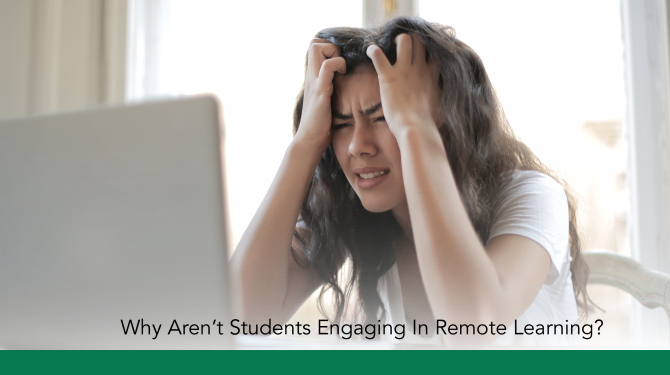What We’ve Learned From Conducting Remote Learning

It has now been more than 17 weeks since Seeds of Literacy shut its classroom doors – without warning – due to COVID-19.
Like other districts in Ohio, Seeds continues to reflect on that time, assessing what needs to be improved to make remote learning sustainable long-term. As K-12 districts struggle to balance the immediate safety of students with the long-term repercussions of waiting, we also face those concerns, along with the concerns of protecting our volunteers and staff.
The choice seems simple: continue remote, online education indefinitely until safety can be guaranteed; but nothing is that simple.
Seeds has learned the hard way that the majority of students simply aren’t responsive to education presented entirely through a computer screen. We know that we’re not alone — many schools report losing track of as many as 50% of their student population through virtual absenteeism.
Why Aren’t Students Participating in Remote Learning?
We spoke with our students, we gathered anecdotes from the tutors who worked with them, and we spoke with our fellow educators. Here’s what we found.
Immediacy of the Pandemic
The suddenness in which COVID-19 closed classrooms took everyone by surprise. Some students didn’t feel the need to adapt to the online programs. They were certain that the virus would go away as quickly as it appeared.
Meanwhile, educators and tutors had no time to prepare for the complete shift in the way they presented materials to students. Most had little to no experience teaching virtually.
As is to be expected, remote instruction began with initial confusion, technological glitches, and strong emotions. At Seeds, students who were willing to jump online were easily discouraged.
Lack of Access
Roughly 88% of Seeds students live at or below the poverty line in Cleveland. Unsurprisingly, few have regular access to computers, internet, or both.
Fear of Technology
Traditional K-12 teachers were surprised to learn that “being a digital consumer/user is very different from being a digital learner,” as one said online. For Seeds students, who came of age long before computers were standard in classrooms, technology is even more frightening. They are reluctant to use the equipment even when access is available.
Lack of Space
Students lucky enough to have the means of participating in remote learning often found themselves without a quiet place to participate. Multiple generations in one home, small apartments, and kids stuck indoors mean that space is at a premium – and family takes priority over a lesson.
Caregiving
As COVID cases began to steadily rise, students found themselves sandwiched between two generations. They had to care for elderly relatives too at risk to go out, as well as children, now without schools of their own to attend. GED prep quickly took a backseat to childcare and ensuring the children completed their own coursework. Some Seeds students are simply exhausted from juggling both caregiving and employment.
Essential Work
Fast food workers, grocery cashiers and stock clerks, cleaners, medical techs and others began working double shifts as their jobs were deemed “essential” and not subject to the state shutdown. This left even less time for education.
Worse, not every non-essential worker was sent to work from home. In fact, many of our students reported being laid off from their jobs. Seeds studying was abandoned as the loss of income became their most immediate priority.
Lack of Incentive
For some students, Seeds provides a critical social aspect to their lives, seeing their friends and tutors before and after class time, chatting during book club. There’s an energy in the classroom that isn’t replicated by logging on. The benefits of the social interaction give them reason to come to class and learn. Without it, students turned their attention toward more pressing needs.
For other students, the reward is the ability to take the test, but testing centers have been closed entirely or open only sporadically throughout the pandemic. Without the immediate reward, students put off learning longer.
What Seeds Has Done Right
Remote learning has been a challenge for everyone, not just Seeds. But there’s hope. We’ve done quite a few things right along the way, and we’re optimistic this will lead to more participation and an even stronger remote learning program in the future.
Quick Response
Seeds responded quickly, pivoting to an online program within just two weeks. This meant we were available to serve our students (and others) when no one else could.
Flexible Times
A hallmark of the traditional Seeds program is our flexibility to suit the needs of individual students. Online learning didn’t change that. We continued to offer tutoring by video and phone almost hourly, four days and evenings a week.
We also recorded our materials for adult learners unable to attend during our available tutoring times.
Technology
We provided tech and training whenever we could. More than 45 students who didn’t have access to computers were provided with them (thanks to generous donors). Socially-distanced training sessions on basic computer use were conducted when students picked up their machines.
Our staff spent hours on the phone, negotiating with cable companies for low-cost internet access and wifi.
Access to Information
We recognized that education would likely take a back seat to the more immediate needs of our students during the early weeks of the pandemic. We sifted through countless resources to identify the partner organizations that could provide critical legal services, medical care, and meals to our students who needed it most.
We also provided our students with simplified information about COVID-19’s spread and prevention. We continue to do this as information and mandates change.
Additions to Programs
We analyzed the initial participation for telephone tutoring and video lessons, and added video “table” tutoring, which closely mimics that classroom setting of one tutor working with several students with individual questions at one table.
And, we shortened our video lessons to encourage more engagement.
Continuous Contact
We’ve maintained continuous contact with our students, making 300+ calls a week, utilizing a text messaging service, sending mass emails, and individual emails from staff. Staff members and other students recorded personalized videos to send and our volunteers wrote encouragement cards for every student.
Even when students haven’t participated in remote learning, they have shared how grateful they are to stay connected to Seeds.
The duration of our classroom closure remains unknown. But one thing is for certain: remote learning is here to stay. We’re proud to say we persevered under pressure to launch this program.
If you or someone you know is interested in becoming a volunteer tutor, please complete the online application found here.
### KLK



